NASA has conceded that climate models lack the precision required to make climate projections due to the inability to accurately model clouds.
Clouds have the capacity to dramatically influence climate changes in both radiative longwave (the “greenhouse effect”) and shortwave.
Cloud cover domination in longwave radiation
In the longwave, clouds thoroughly dwarf the CO2 climate influence. According to Wong and Minnett (2018):
• The signal in incoming longwave is 200 W/m² for clouds over the course of hours. The signal amounts to 3.7 W/m² for doubled CO2 (560 ppm) after hundreds of years.
• At the ocean surface, clouds generate a radiative signal 8 times greater than tripled CO2 (1120 ppm).
• The absorbed surface radiation for clouds is ~9 W/m². It’s only 0.5 W/m² for tripled CO2 (1120 ppm).
• CO2 can only have an effect on the first 0.01 mm of the ocean. Cloud longwave forcing penetrates 9 times deeper, about 0.09 mm.
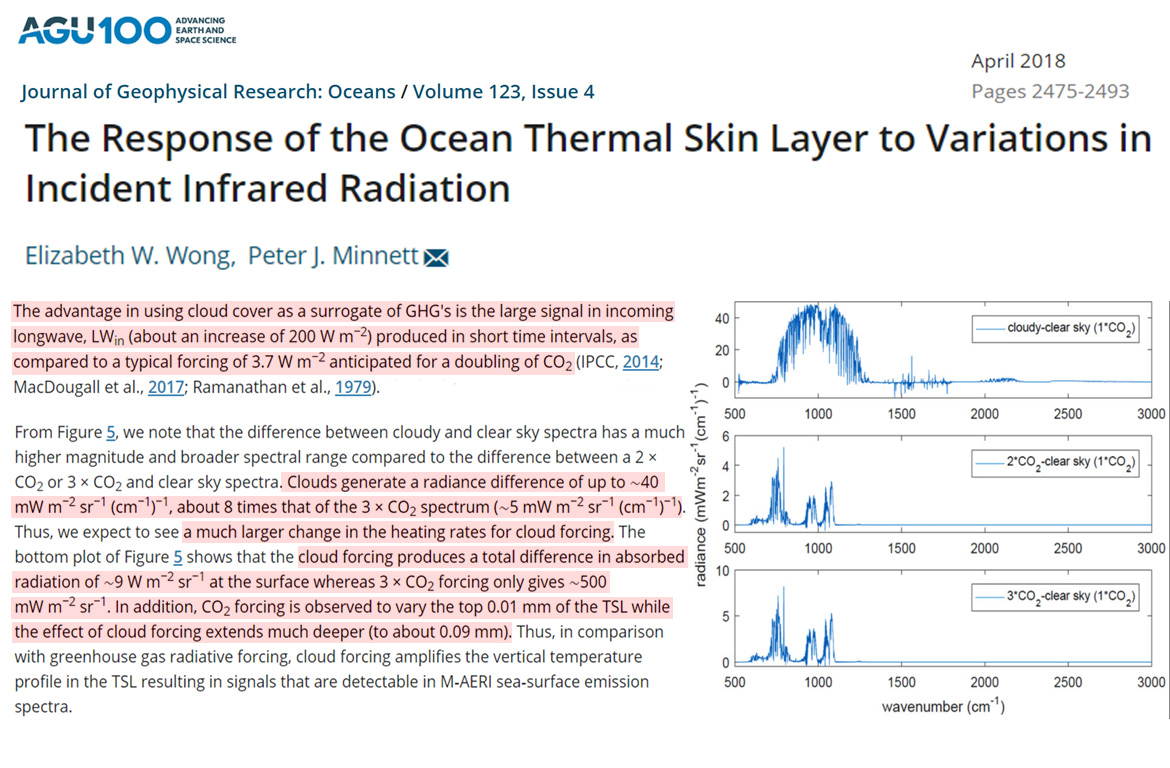
Image Source: Wong and Minnett, 2018
Cloud cover domination in shortwave radiation
In its shortwave albedo capacity, cloud cover modulates the amount of solar radiation that warms the ocean. Changes in the Earth’s radiation budget “are caused by changes in tropical mean cloudiness.” (Wielicki et al., 2002).
When cloud cover increases, less shortwave radiation reaches the surface, leading to cooling. When cloud cover decreases – as it has since the 1980s – more solar radiation is absorbed.
The decrease in cloud cover in recent decades can therefore explain the 1979-2017 warming (Herman et al., 2013, Poprovsky, 2019, Loeb et al., 2018).
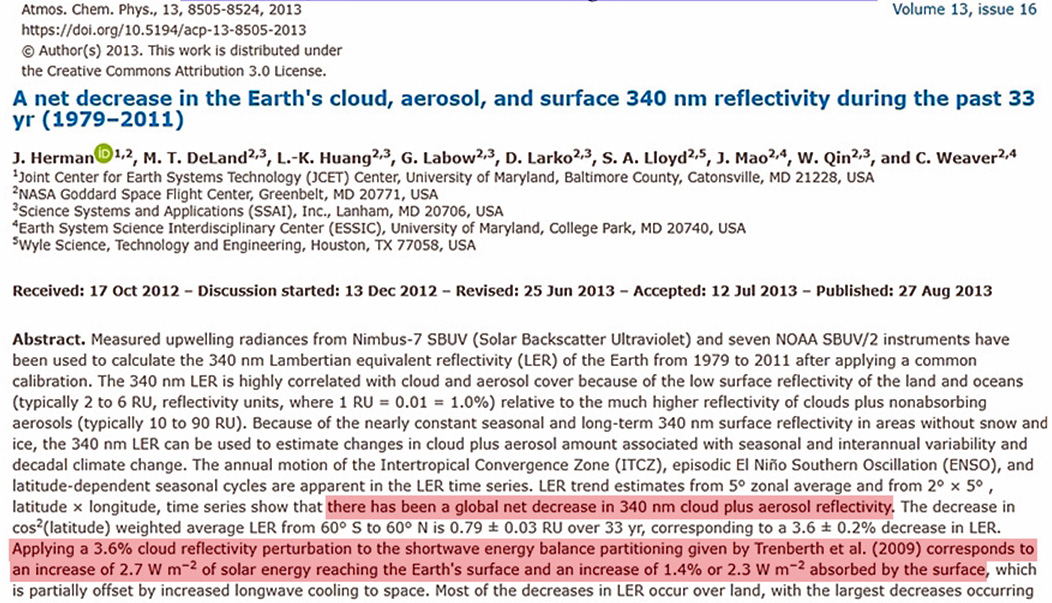
Image Source: Herman et al., 2013
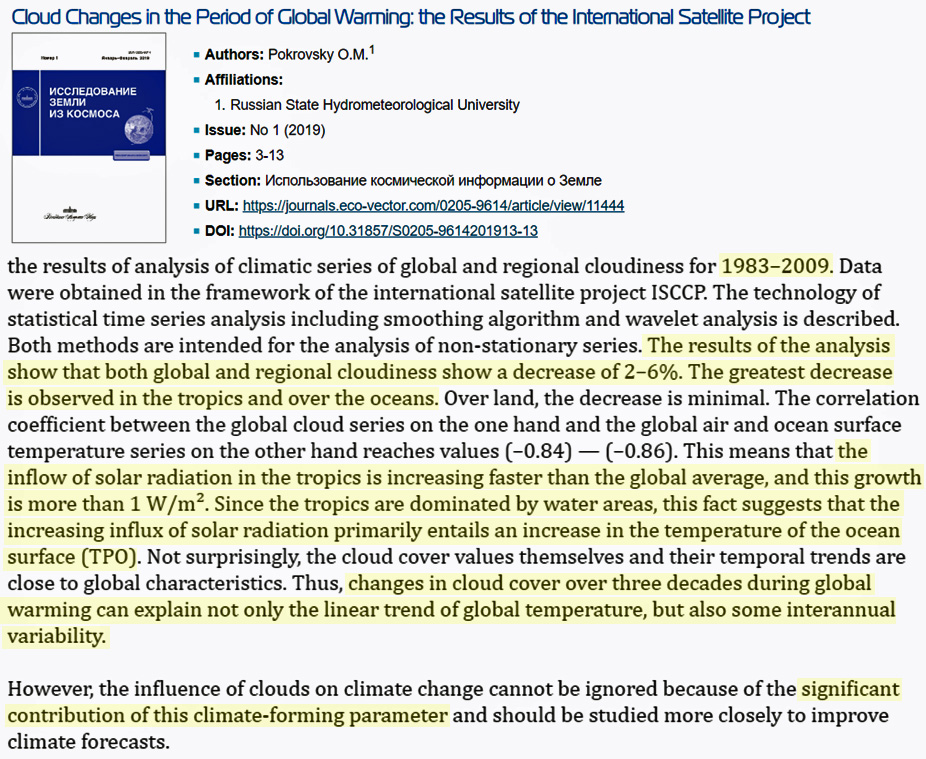
Image Source: Poprovsky, 2019
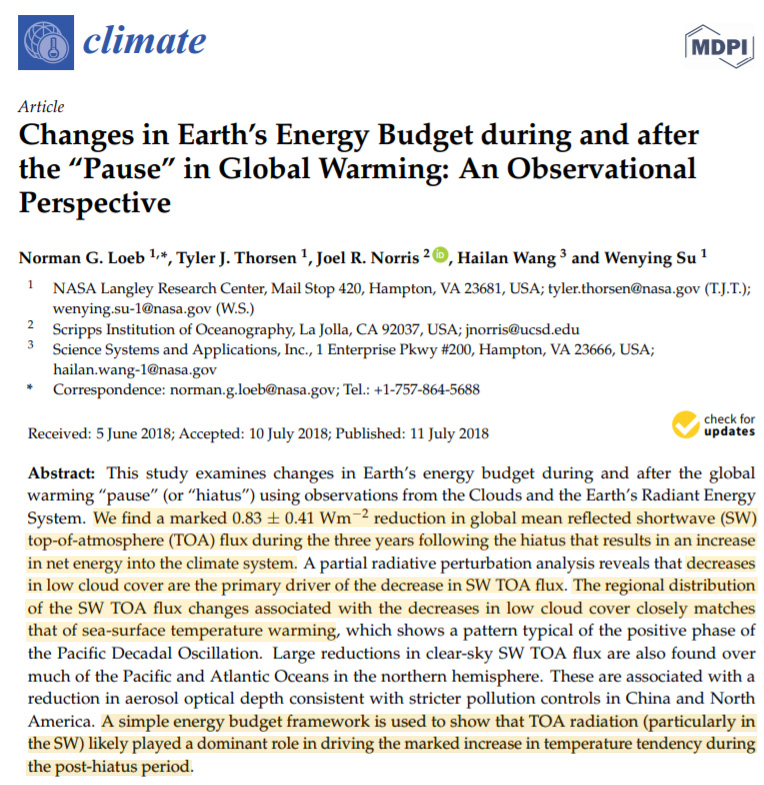
Image Source: Loeb et al., 2018
IPCC and NASA acknowledge that we can’t model clouds with requisite accuracy
The IPCC has admitted there is a great deal of “continuing uncertainty” in the sign and magnitude of the cloud influence. Most models indicate a positive feedback (more warming), but this “is not well understood” and the IPCC scientists “are not confident that it is realistic.”
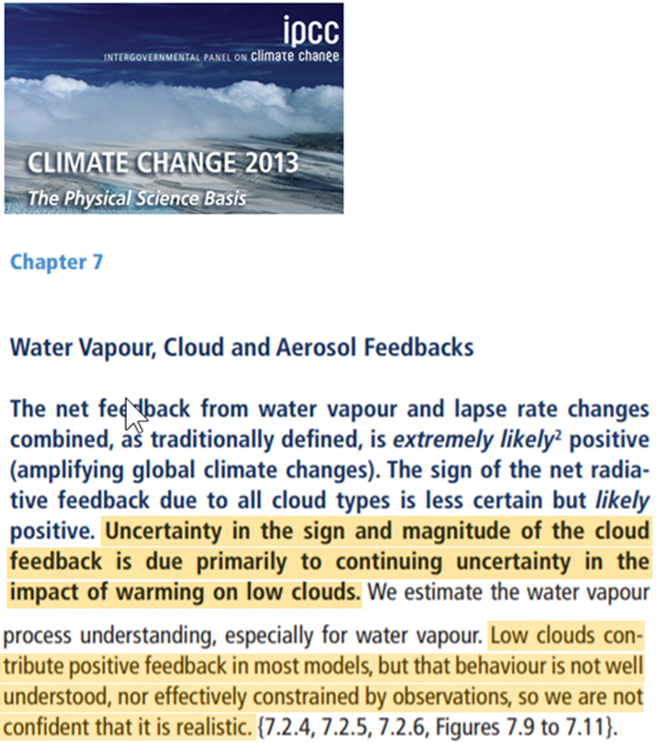
Image Source: IPCC (2013)
NASA has been even more candid about the massive uncertainties associated with cloud climatology.
Some clouds “cool more than they heat” and other clouds “warm more than they cool.”
In some models “clouds decrease the net greenhouse effect, whereas in others they intensify it.”
Because the uncertainties are so pervasive, NASA concludes that “today’s models must be improved by about a hundredfold in accuracy” if we wish to make climate projections.

Image Source: NASA
Uncertainty in the effects of cloud forcing are 20-40 times larger than the projected greenhouse gas warming for the next century
Due to the enormous uncertainties associated with cloud cover changes, the IPCC’s CO2 emission scenarios used to calculate warming are reduced to the realm of nearly evidence-free presumption.
Using the IPCC’s emission scenarios, for example, the projected greenhouse gas-induced warming by 2100 is 3.7°C. Due to cloud forcing errors, the uncertainty in this projection is ±130°C!
“When both the cloud and the forcing uncertainties are allowed to accumulate together, after 5 years the A2 [greenhouse gas-induced] scenario includes a 0.34°C warmer Earth but a ±8.8°C uncertainty. At 10 years this becomes 0.44±15° C, and 0.6±27.7°C in 20 years. By 2100, the projection is 3.7±130°C.”
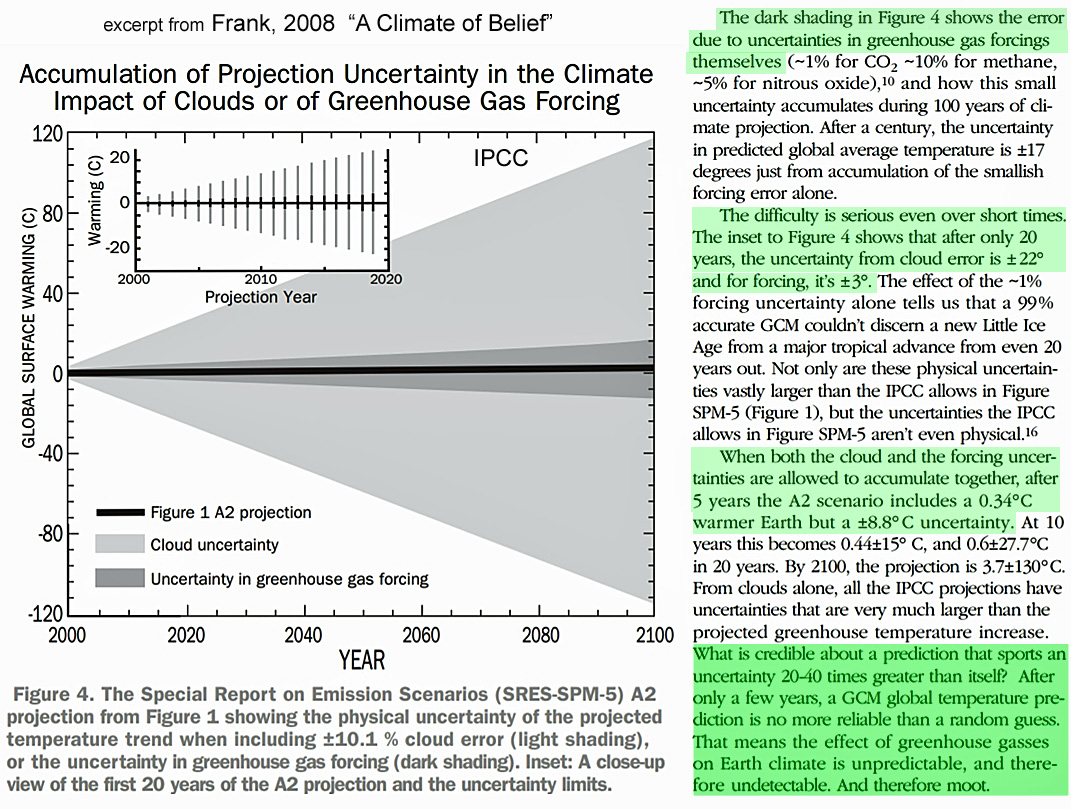
Image Source: Frank, 2008
Unless we can model clouds, we cannot model climate with any precision
Due to the dominant influence of cloud cover in facilitating climate change, dramatically improving our woefully insufficient capacity to model clouds is both necessary and fundamental.
Climate science should rise to the challenge rather than continuing to gloss over or even dismiss the profound cloud modeling problem undermining climate projections.





Is NASA saying there is a physics problem, or a modelling/numeric problem? One look at Svensmark’s aerosol modelling and actual test with Forbush decreases shows how easy it is to get the physics wrong. As regards the statement that some clouds cool and others warm there is something interesting.
Could it be the modelling is beyond available HPC capacity, and more power is needed?
You cannot forecast the climate on the long term even if you would have an infinite speed, infinite memory computer. The Lyapunov exponents take care of that. More info, here: https://compphys.go.ro/chaos/
Worth looking over the links, too. The cherry on top is at the end, with a ‘climate model’ that was used for propaganda, having a fatal bug.
It is not an either or question!
We know very little about cloud physics because there is not a standard cloud. Clouds are very individual and what they do and how react to the continuously changing atmosphere varies (variations affecting clouds’ structure, energy balance, and movement, such as local temperature, humidity, and chemistry changes, plus solar and cosmic ray changes). Yes there are some broad generalities that are covered when assessing clouds but overall they are a massive black hole in our knowledge of atmospheric physics.
Given that clouds are such an enigma, modeling them is a huge problem and most models fudge the problem by ‘parameterization’ and ‘tuning’ the model for the required output. Some other models are fed some statistics about the current OBSERVED cloud data. Whichever method is employed, the propagation of errors over time will accumulate ensuring that climate models output are invariably wrong about the long term (or at least having very low confidence/high error margins).
In a chaotic system such as weather & climate it is paramount that the initial conditions are known to a very high precision and accuracy, and that the dynamic physics are well known in order to design and run good numerical climate models. Any deviation from this requirement ensures that modeled errors accumulate over time, and will deflect the models’ output from reality.
Note that NO climate model is initialized with known current conditions, they are initialized with unreal conditions that give the required climatic evolutions.
As one of the top climate scientists in the world, Kevin Trenberth said in journal Nature (“Predictions of Climate”) about climate models back in in 2007:
The irony of the whole, sad Climate Alarmism tale is that we do need to study and understand climate. The present funding levels are not burdensome. The problem is that most are generating propaganda and not science.
Richard Lindzen, et al., published an interesting paper on low and high level clouds’ effect on insolation in the infrared spectrum, raising a question whether there was a moderating “iris effect” in cloud formation. See “Does the Earth Have an Adaptive Infrared Iris?” Pages 417-432 Bulletin of the American Meteorological Society, vol. 82, no. 3, March 2001.
Thanks.
This appears to be the short short version.
https://www.youtube.com/watch?v=2ZTRCJ2kWHg
LONG VERSION
http://www-eaps.mit.edu/faculty/lindzen/adinfriris.pdf
Whoever would have thought that cloud cover has an effect on temperature???
You just can’t make this stuff up.
A possible effect of changes in cloud cover particularly over the tropics, mostly ocean and where insolation is at its greatest, has been observed:
http://www.climate4you.com/images/HadCRUT3%20and%20TropicalCloudCoverISCCP.gif
SMHI can´t either. But sun is more present and it is getting hotter.
https://www.smhi.se/polopoly_fs/1.143989.1548428766!/image/allsack_1983-lastyear.jpg_gen/derivatives/Original_1256px/image/allsack_1983-lastyear.jpg
I wounder how they could model this? …
Bacteria feeding on Arctic algae blooms can seed clouds
From https://phys.org/news/2019-08-bacteria-arctic-algae-blooms-seed.html
[…] https://notrickszone.com/2019/08/29/nasa-we-cant-model-clouds-so-climate-models-are-100-times-less-a… […]
[…] https://notrickszone.com/2019/08/29/nasa-we-cant-model-clouds-so-climate-models-are-100-times-less-a… […]
[…] https://notrickszone.com/2019/08/29/nasa-we-cant-model-clouds-so-climate-models-are-100-times-less-a… […]
[…] https://notrickszone.com/2019/08/29/nasa-we-cant-model-clouds-so-climate-models-are-100-times-less-a… […]
[…] Fonte: No Tricks Zone […]